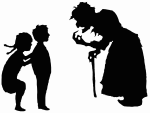Plot
Three brothers are warned daily by their mother not to venture into the woods adjacent to their village; according to their grandmother, the forest is the domain of a "Witch-Woman" who eats children and uses their bones to build a fence around her house. One day, the two elder brothers, Big-One and In-the-Middle, take a chance and willingly enter the forest, unafraid of the supposed Witch-Woman. Teeny-Tiny, the youngest brother, reluctantly follows them, but keeps "[his] eyes open and [his] legs ready to run". The boys spend all afternoon playing in the forest, but when it grows dark, the three become lost, hungry and tired. Searching for a way out of the woods, Teeny-Tiny climbs a tree and spots a light in the distance. He and his brothers follow the light to a cottage owned by a grotesque old woman who offers them food and shelter for the night.
While Big-One and In-the-Middle sleep, the restless Teeny-Tiny looks out of the bedroom window and notices a knobby white fence made of children's bones. As Teeny-Tiny realizes that their hostess is the Witch-Woman, she calls out to the boys to ascertain their collective slumber. Teeny-Tiny resists sleep and contrives a series of bedtime rituals to stall for time, eventually requesting water in a sieve. When the Witch-Woman prepares for this task, Teeny-Tiny overhears her placing three magic objects upon a kitchen shelf: a bar of soap, a sewing needle, and a short knife.
Teeny-Tiny wakes his brothers and warns them of the Witch-Woman, and the three brothers escape, with Teeny-Tiny stealing the three magic objects. The Witch-Woman, still engrossed in her futile chore, catches sight of the fleeing boys and gives chase. Teeny-Tiny uses the magic objects to maintain a distance from the pursuing Witch-Woman. The soap creates a mountain of foam and the needle multiplies into a mountain of needles, but they prove only slight obstacles to the Witch-Woman, who maneuvers around both mountains. The knife, however, carves a canyon too long and wide for the Witch-Woman to run around or jump over, allowing Teeny-Tiny and his brothers to return safely home.
This page is based on this
Wikipedia article Text is available under the
CC BY-SA 4.0 license; additional terms may apply.
Images, videos and audio are available under their respective licenses.

